Ultra-flexible electronic slime takes cues from shape-shifting amoeba
 Scientists have developed a highly deformable, adhesive electronic hydrogel inspired by amoebas that could enable customizable epidermal electronics.
Scientists have developed a highly deformable, adhesive electronic hydrogel inspired by amoebas that could enable customizable epidermal electronics.

 Subscribe to our Nanotechnology Spotlight feed
Subscribe to our Nanotechnology Spotlight feed
 Scientists have developed a highly deformable, adhesive electronic hydrogel inspired by amoebas that could enable customizable epidermal electronics.
Scientists have developed a highly deformable, adhesive electronic hydrogel inspired by amoebas that could enable customizable epidermal electronics.
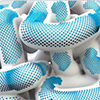 Researchers have developed a method for integrating functional nanopatterns with comfortable textiles, enabling applications like non-invasive glucose sensing and light-activated antimicrobial masks.
Researchers have developed a method for integrating functional nanopatterns with comfortable textiles, enabling applications like non-invasive glucose sensing and light-activated antimicrobial masks.
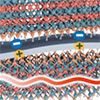 Scientists devise a novel strategy to completely maximize inexpensive MXene materials for scalable and reliable electronic fabrics with integrated capabilities.
Scientists devise a novel strategy to completely maximize inexpensive MXene materials for scalable and reliable electronic fabrics with integrated capabilities.
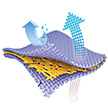 Functional, nanoengineered textiles are designed to enhance human comfort in outdoor activities that require cooling, warming, or drying, resulting in improved comfort levels and increased productivity in outdoor work. Furthermore, there is the potential for functional textiles to be integrated with IoT devices for a range of applications, including healthcare, sports, and fashion, demonstrating how nanotechnology can be used to create smart textiles that can provide real-time data on various metrics.
Functional, nanoengineered textiles are designed to enhance human comfort in outdoor activities that require cooling, warming, or drying, resulting in improved comfort levels and increased productivity in outdoor work. Furthermore, there is the potential for functional textiles to be integrated with IoT devices for a range of applications, including healthcare, sports, and fashion, demonstrating how nanotechnology can be used to create smart textiles that can provide real-time data on various metrics.
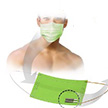 New research describes the first example of self-powered bioelectronics on a mask that can measure the biological glucose signal with continuous energy. In their work, the researchers demonstrate a 3-in-1 mask device that can 1) harvest energy (a biofuel cell); 2) store energy (a supercapacitor); and 3) indicate glucose concentration (a biosensor). The small biofuel cells can harvest energy from the sweat on a person's face and indicate the level of the analyte that tracks health and nutrition.
New research describes the first example of self-powered bioelectronics on a mask that can measure the biological glucose signal with continuous energy. In their work, the researchers demonstrate a 3-in-1 mask device that can 1) harvest energy (a biofuel cell); 2) store energy (a supercapacitor); and 3) indicate glucose concentration (a biosensor). The small biofuel cells can harvest energy from the sweat on a person's face and indicate the level of the analyte that tracks health and nutrition.
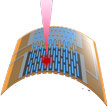 In order to realize practical device applications of stretchable strain sensors, stability without sacrificing sensitivity, stretchability, and scalability is crucial. To that end, researchers report a kirigami-structured graphene-polymer hybrid nanocomposite for strain sensors by a laser direct writing technique on a polyimide sheet. The approach of laser direct writing not only contributes to the conversion of polyimide material into conductively porous carbonized film, but also gives rise to the formation of kirigami-shaped structures with highly stretchable capability in a fast and efficient manner.
In order to realize practical device applications of stretchable strain sensors, stability without sacrificing sensitivity, stretchability, and scalability is crucial. To that end, researchers report a kirigami-structured graphene-polymer hybrid nanocomposite for strain sensors by a laser direct writing technique on a polyimide sheet. The approach of laser direct writing not only contributes to the conversion of polyimide material into conductively porous carbonized film, but also gives rise to the formation of kirigami-shaped structures with highly stretchable capability in a fast and efficient manner.
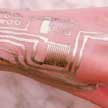 Skin-interfaced, wearable electronics have attracted significant attention due to their unique roles in preventative monitoring, diagnostic confirmation, and convenient therapeutic options. The ultimate application of these bio-integrated devices for practical and convenient applications hinges on the seamless integration of on-body sensors with wireless transmission modules. As a promising direction toward this class of integrated systems, soft body area sensor networks include on-body sensors for physiological signal monitoring and flexible printed circuit boards for signal conditioning/readout and wireless transmission.
Skin-interfaced, wearable electronics have attracted significant attention due to their unique roles in preventative monitoring, diagnostic confirmation, and convenient therapeutic options. The ultimate application of these bio-integrated devices for practical and convenient applications hinges on the seamless integration of on-body sensors with wireless transmission modules. As a promising direction toward this class of integrated systems, soft body area sensor networks include on-body sensors for physiological signal monitoring and flexible printed circuit boards for signal conditioning/readout and wireless transmission.
 Researchers report the direct writing of laser-induced graphene on a Kevlar textile. The transformation of Kevlar into graphene can be attributed to the photothermal effect induced by CO2 laser irradiation. Specifically, this resulted in high localized temperature, leading to the ablation and depolymerization of the Kevlar fiber. The remaining carbon atoms are recombined and 'recrystallized' into graphene. Based on this technique, it becomes feasible to prepare various types of flexible electronics on different commercial textiles such as silk and cotton. This will enable the efficient and customized preparation of multi-functional textile electronics.
Researchers report the direct writing of laser-induced graphene on a Kevlar textile. The transformation of Kevlar into graphene can be attributed to the photothermal effect induced by CO2 laser irradiation. Specifically, this resulted in high localized temperature, leading to the ablation and depolymerization of the Kevlar fiber. The remaining carbon atoms are recombined and 'recrystallized' into graphene. Based on this technique, it becomes feasible to prepare various types of flexible electronics on different commercial textiles such as silk and cotton. This will enable the efficient and customized preparation of multi-functional textile electronics.